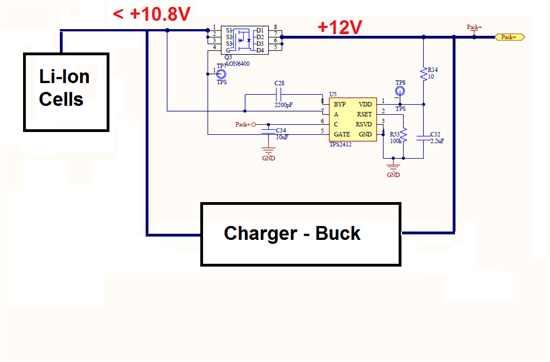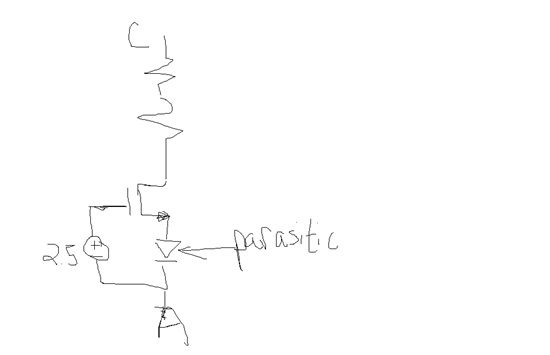My customer is having a problem with the TPS2410 (see attached schematic).
The ideal diode functions as expected and is used as a bidirectional current control.
The 12V bus is connected to the C pin as per page 22 of the spec sheet (Bidirectional control and blocking).
The issue with the device is when the ideal diode is disabled.
Signal BBU_ENABLE_L is active low, 12V bus goes low and VBAT1 (battery voltage) is 15-20V.
No power can be pulled from the battery but a voltage is measured on the 12V bus in the order of 3V.
The customer is monitoring the 12V bus. If there is a voltage, the host assumes the 12V bus is ok.
What can be accomplished to remove this voltage on the 12V bus?
The voltage is leaking from the resistance between the a and C pins on the controller.
Here are testing results. The C-pin current is way outside of specification. The total current is not accounted for (IN = OUT). It appears that Vac ~= -1.8V is a threshold for sourcing/draining current from the A-pin.
|
Test Name |
C-Voltage (V) |
A-Voltage (V) |
A-Pin current (uA) |
C-Pin Current (uA) |
GND-Pin Current (uA) |
Comment |
Voltage Delta (External - Cell) (V) |
|
Minimum PS-V #1 |
11.64 |
7.2 |
-530 |
|
|
A pin charges the cell stack |
4.44 |
|
Minimum PS-V #2 |
10.11 |
77 |
|
|
A pin discharges the cell stack |
1.53 |
|
|
Minimum PS-V #3 |
10.44 |
176 |
|
|
A pin discharges the cell stack |
1.20 |
|
|
Minimum PS-V #4 |
10.65 |
245 |
|
|
A pin discharges the cell stack |
0.99 |
|
|
Nominal PS-V #1 |
12.20 |
7.2 |
-566 |
1225 |
3074 |
A pin charges the cell stack |
5.00 |
|
Nominal PS-V #2 |
10.11 |
-88 |
1225 |
2999 |
A pin charges the cell stack |
2.09 |
|
|
Nominal PS-V #3 |
10.44 |
12 |
1225 |
2985 |
A pin discharges the cell stack |
1.76 |
|
|
Nominal PS-V #4 |
10.65 |
88 |
1225 |
2977 |
A pin discharges the cell stack |
1.55 |
|
|
Maximum PS-V #1 |
12.36 |
7.2 |
-570 |
|
|
A pin charges the cell stack |
5.16 |
|
Maximum PS-V #2 |
10.11 |
-135 |
|
|
A pin charges the cell stack |
2.25 |
|
|
Maximum PS-V #3 |
10.44 |
-36 |
|
|
A pin charges the cell stack |
1.92 |
|
|
Maximum PS-V #4 |
10.65 |
28 |
|
|
A pin discharges the cell stack |
1.71 |





